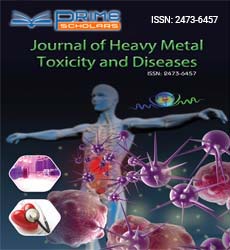Commentary - (2023) Volume 8, Issue 3
Chelation Therapy for Neurological Disorders Arising Due to Metal Poisoning
Zhang Lan*
Department of Chemistry, Lanzhou University, China
*Correspondence:
Zhang Lan,
Department of Chemistry, Lanzhou University,
China,
Email:
Received: 01-May-2023, Manuscript No. ipjhmct-23-17452;
Editor assigned: 03-May-2023, Pre QC No. ipjhmct-23-17452 (PQ);
Reviewed: 17-May-2023, QC No. ipjhmct-23-17452;
Revised: 22-May-2023, Manuscript No. ipjhmct-23-17452 (R);
Published:
29-May-2023, DOI: 10.21767/2473-6457.23.3.24
Description
Neurological disorders resulting from metal poisoning have become
a growing concern in recent years, as industrialization and
environmental factors expose individuals to various toxic metals
such as lead, mercury, and cadmium. These heavy metals can accumulate
in the body over time, leading to severe neurological
damage and cognitive impairment. In such cases, chelation therapy
has emerged as a promising treatment option to mitigate the
effects of metal poisoning on the central nervous system. Metal
poisoning occurs when the body is exposed to high levels of toxic
metals, either through occupational exposure, contaminated
food and water sources, or other environmental factors. Once
these metals enter the bloodstream, they can cross the bloodbrain
barrier and accumulate in neural tissues, disrupting normal
cellular processes. Over time, this accumulation can lead to
a range of neurological disorders, including cognitive decline,
memory loss, motor dysfunction, and even more severe conditions
such as Parkinson’s disease and Alzheimer’s disease. Chelation
therapy involves the administration of chelating agents,
which are compounds designed to bind with and remove toxic
metals from the body. These agents have a high affinity for certain
metals, forming stable complexes that are then excreted
through urine or feces. The primary goal of chelation therapy in
cases of metal-induced neurological disorders is to reduce the
metal burden in the body, thereby minimizing further damage
to the nervous system. One of the most commonly used chelating
agents is ethylenediaminetetraacetic acid (EDTA). EDTA forms
stable complexes with a variety of metals, making it effective in
removing heavy metals like lead and mercury from the body. Other
chelating agents include dimercaptosuccinic acid (DMSA) and
dimercaprol (BAL), each with specific affinities for different metals.
Chelation therapy has shown promise in treating neurological
disorders arising from metal poisoning, particularly in cases of
acute heavy metal poisoning. In lead poisoning, for instance,chelation
therapy has been demonstrated to reduce blood lead levels
and improve cognitive function in children with lead toxicity.
Similarly, studies have suggested that chelation therapy may be
beneficial for mercury toxicity, especially in cases of methylmercury
exposure. However, the efficacy of chelation therapy for
chronic metal exposure and its associated neurological disorders
remains a topic of debate. Some studies have reported positive
outcomes, while others have shown limited benefits. It’s important
to note that chelation therapy is not without risks and potential
side effects, including kidney damage, allergic reactions,
and disturbances in mineral balance. Therefore, the decision to
pursue chelation therapy should be carefully considered and individualized
based on the specific metal involved, the severity of
toxicity, and the overall health of the patient. Chelation therapy is
often used in conjunction with other treatment modalities to optimize
outcomes. Nutritional supplements such as antioxidants
and essential minerals may be administered alongside chelating
agents to counteract the oxidative stress and mineral imbalances
associated with metal poisoning. In the realm of research, advancements
in targeted chelation therapies are being explored to
enhance the selectivity and efficacy of metal removal. Nanoparticles
and molecularly engineered compounds are being developed
to specifically target metal ions in affected tissues while
minimizing damage to healthy cells. Such innovations hold the
potential to revolutionize chelation therapy and provide more effective
treatments for metal-induced neurological disorders.
Acknowledgement
None.
Conflict Of Interest
The author states there is no conflict of interest.
Citation: Lan Z (2023) Chelation Therapy for Neurological Disorders Arising due to Metal Poisoning. J Heavy Met Toxicity Dis.
08:24.
Copyright: © 2023 Lan Z. This is an open-access article distributed under the terms of the Creative Commons Attribution License,
which permits unrestricted use, distribution, and reproduction in any medium, provided the original author and source are
credited.

